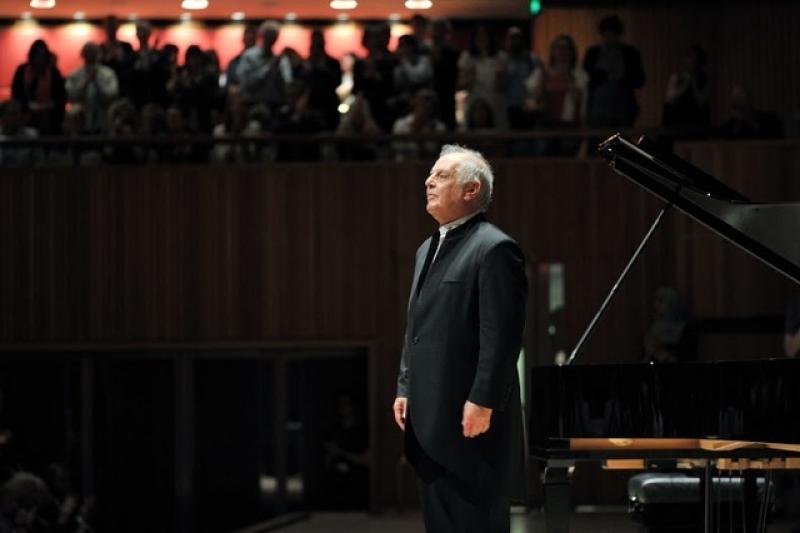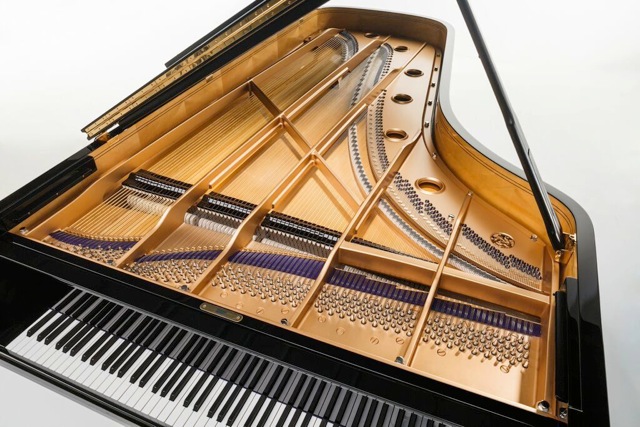Schubert Sonatas 4, Barenboim, RFH | reviews, news & interviews
Schubert Sonatas 4, Barenboim, RFH
Schubert Sonatas 4, Barenboim, RFH
Barenboim and that piano plumb the heart of darkness in Schubert's farewell

One man and his piano can occasionally fulfil a role more satisfying than the finest orchestra in full sail. The last of Daniel Barenboim's four-recital traversal of Schubert's piano sonatas proved just such an occasion.
And that is what's needed when a piano is so radically different from those to which we're accustomed... Yes, I know, we've dealt with the Barenboim own-brand instrument already, but its significance is growing, rather than the reverse. Watching and listening to Barenboim playing it is like witnessing a man in love. This relationship is still new, starry-eyed and fresh, his discovery of his musical partner's capabilities ongoing and full of surprises; and the joy with which he appears to show us its range is hard to mask even in the darkest depths of Schubert's late sonatas. Comparisons with Steinway or Fazioli would be invidious: after all, there's little that such a pianist cannot do with those, as anyone who heard his Beethoven series a few years back will know.
It was in the slow movement that Barenboim ventured into territories that few others would dare to explore
Barenboim, with his conductor's awareness of sonic colour, can work wonders with any instrument at his disposal because the sound-colour is in his mind first and foremost. Yet this straight-strung, lighter-bodied invention (pictured below), aiming to combine the best of 19th- and 21st-century concert grands, taking its cues from one of Liszt's, allows him to find shadings of colour, especially at soft levels, that offer new realms of possibility. Even in the last movement of the last sonata (D.960) there was a sense that he is still playing with this lavish new toy: the open octaves that start and then punctuate this music gave him ample scope to demonstrate that no two need sound the same. With varied touch, different approaches to attack and release, he could hollow out the tone, or sustain it, or shadow it with kaleidoscopic variants.
I'd experienced a certain discomfort with his approach to the early sonatas in the first concert, but this recital was a different story altogether. It contained two of the finest late works: the A minor Sonata D.845, the most substantial of Schubert's three in this key; and after the interval, the last sonata, the B flat major D.960 (the former is played too little by recitalists in general, the latter possibly too often). The A minor is a bleak, rugged, unsettled and unsettling work, at times with an atmosphere akin to an escaped sibling of Winterreise: "ohne Ruh', und suche Ruh'" ("without peace and seeking peace") like the song-cycle's protagonist in "Der Wegweiser". The slow movement, a set of variations, can sometimes lighten the load, but not always – and not here – for often in late Schubert the major feels more tragic than the minor. Barenboim navigated the entire span like a symphony, giving us the impression that he was orchestrating it even while improvising it, for such is his identification with the music that he has made it entirely his own.
 The B flat Sonata D.960 is the Holy Grail of Schubert sonatas, his very last, dating from shortly before his untimely death at the age of 31. Its generous paragraphs and twilit atmospheres, interrupted by a deep bass trill that leaves us staring into the void, questions unresolved, demand the ultimate in sonic control and concentration: Barenboim evoked a range of colour that embraced not only sound, but silence too. No two silences were identical – the build-up in the first movement shortly before the exposition's close leads to a ferocious chord like a slammed door; but the last bass trill of the development, after those faraway considerations of the opening theme over pulsing chords – as if measuring time about to run out – left us facing a fearsome vacuum that could stop both heart and breath. Barenboim omitted the exposition repeat which would have brought us Schubert's linking passage back to the start, containing the movement's one loud statement of that trill; some of us had hoped to hear it, yet on the other hand perhaps the trill and silence at the end of the development was all the more powerful for that.
The B flat Sonata D.960 is the Holy Grail of Schubert sonatas, his very last, dating from shortly before his untimely death at the age of 31. Its generous paragraphs and twilit atmospheres, interrupted by a deep bass trill that leaves us staring into the void, questions unresolved, demand the ultimate in sonic control and concentration: Barenboim evoked a range of colour that embraced not only sound, but silence too. No two silences were identical – the build-up in the first movement shortly before the exposition's close leads to a ferocious chord like a slammed door; but the last bass trill of the development, after those faraway considerations of the opening theme over pulsing chords – as if measuring time about to run out – left us facing a fearsome vacuum that could stop both heart and breath. Barenboim omitted the exposition repeat which would have brought us Schubert's linking passage back to the start, containing the movement's one loud statement of that trill; some of us had hoped to hear it, yet on the other hand perhaps the trill and silence at the end of the development was all the more powerful for that.
Nevertheless, it was in the slow movement that Barenboim ventured into territories that few others would dare to explore. Never mind the andante sostenuto marking – the tempo he chose for a creation sometimes compared to a barcarolle (its songful melody in thirds, the accompaniment figuration potentially suggestive of oars dipped into shadowed water) was very slow indeed, very inward – if this was a river, it was the Styx. From its blackest depths, the central section emerged as a powerful, eloquent oration, the piano's tenor range reaching its apex of beauty. In this movement Barenboim led us, like some modern-day Orpheus, into Schubert's heart of darkness and extrapolated from it, ultimately, a form of peace.
The more public faces of the Scherzo and the Finale proved cathartic, though no less rapt and involving. The ovation was immediate and prolonged as Barenboim bestrode the stage, acknowledging different sections of his public one at a time. On a more mundane note, there was a lesson here in how to stop people taking photos during a curtain call: you have to be Barenboim and wield that type of authority. One arm gesture from this maestro and nobody could budge.
The future of Arts Journalism
You can stop theartsdesk.com closing!
We urgently need financing to survive. Our fundraising drive has thus far raised £49,000 but we need to reach £100,000 or we will be forced to close. Please contribute here: https://gofund.me/c3f6033d
And if you can forward this information to anyone who might assist, we’d be grateful.

Subscribe to theartsdesk.com
Thank you for continuing to read our work on theartsdesk.com. For unlimited access to every article in its entirety, including our archive of more than 15,000 pieces, we're asking for £5 per month or £40 per year. We feel it's a very good deal, and hope you do too.
To take a subscription now simply click here.
And if you're looking for that extra gift for a friend or family member, why not treat them to a theartsdesk.com gift subscription?
more Classical music
 Echo Vocal Ensemble, Latto, Union Chapel review - eclectic choral programme garlanded with dance
Beautiful singing at the heart of an imaginative and stylistically varied concert
Echo Vocal Ensemble, Latto, Union Chapel review - eclectic choral programme garlanded with dance
Beautiful singing at the heart of an imaginative and stylistically varied concert
 Scott, Irish Baroque Orchestra, Whelan, RIAM, Dublin review - towards a Mozart masterpiece
Characteristic joy and enlightenment from this team, but a valveless horn brings problems
Scott, Irish Baroque Orchestra, Whelan, RIAM, Dublin review - towards a Mozart masterpiece
Characteristic joy and enlightenment from this team, but a valveless horn brings problems
 Classical CDs: Voice flutes, flugelhorns and froth
Baroque sonatas, English orchestral music and an emotionally-charged vocal recital
Classical CDs: Voice flutes, flugelhorns and froth
Baroque sonatas, English orchestral music and an emotionally-charged vocal recital
 Kanneh-Mason, Britten Sinfonia, Shave, Milton Court - a grin and a big beaming smile
A pair of striking contemporary pieces alongside two old favourites
Kanneh-Mason, Britten Sinfonia, Shave, Milton Court - a grin and a big beaming smile
A pair of striking contemporary pieces alongside two old favourites
 theartsdesk at the New Ross Piano Festival - Finghin Collins’ musical rainbow
From revelatory Bach played with astounding maturity by a 22 year old to four-hand jazz
theartsdesk at the New Ross Piano Festival - Finghin Collins’ musical rainbow
From revelatory Bach played with astounding maturity by a 22 year old to four-hand jazz
 First Person: Manchester Camerata's Head of Artistic Planning Clara Marshall Cawley on questioning the status quo
Five days of free events with all sorts of audiences around Manchester starts tomorrow
First Person: Manchester Camerata's Head of Artistic Planning Clara Marshall Cawley on questioning the status quo
Five days of free events with all sorts of audiences around Manchester starts tomorrow
 Goldscheider, Brother Tree Sound, Kings Place review - music of hope from a young composer
Unusual combination of horn, strings and electronics makes for some intriguing listening
Goldscheider, Brother Tree Sound, Kings Place review - music of hope from a young composer
Unusual combination of horn, strings and electronics makes for some intriguing listening
 theartsdesk Q&A: composer Donghoon Shin on his new concerto for pianist Seong-Jin Cho
Classical music makes its debut at London's K-Music Festival
theartsdesk Q&A: composer Donghoon Shin on his new concerto for pianist Seong-Jin Cho
Classical music makes its debut at London's K-Music Festival
 Helleur-Simcock, Hallé, Wong, Bridgewater Hall, Manchester review - moving lyricism in Elgar’s concerto
Season opener brings lyrical beauty, crisp confidence and a proper Romantic wallow
Helleur-Simcock, Hallé, Wong, Bridgewater Hall, Manchester review - moving lyricism in Elgar’s concerto
Season opener brings lyrical beauty, crisp confidence and a proper Romantic wallow
 Kohout, Spence, Braun, Manchester Camerata, Huth, RNCM, Manchester review - joy, insight, imagination and unanimity
Celebration of the past with stars of the future at the Royal Northern College
Kohout, Spence, Braun, Manchester Camerata, Huth, RNCM, Manchester review - joy, insight, imagination and unanimity
Celebration of the past with stars of the future at the Royal Northern College

Add comment